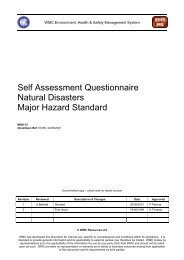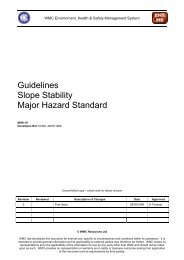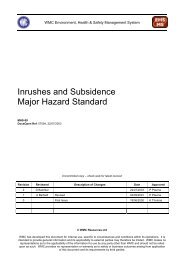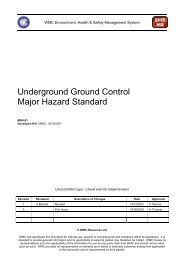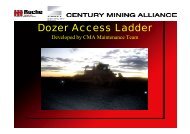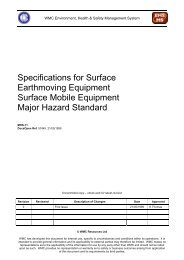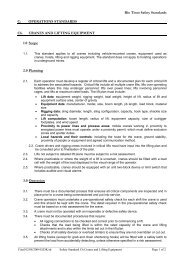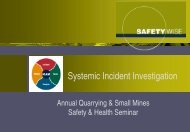Aviation Major Hazard Standard - MIRMgate
Aviation Major Hazard Standard - MIRMgate
Aviation Major Hazard Standard - MIRMgate
You also want an ePaper? Increase the reach of your titles
YUMPU automatically turns print PDFs into web optimized ePapers that Google loves.
<strong>Major</strong> <strong>Hazard</strong> <strong>Standard</strong><br />
MHS 03 - <strong>Aviation</strong> <strong>Standard</strong> documen Revision 3<br />
issued 20 August 2001<br />
** Uncontrolled copy. Use latest revision **<br />
Passenger emergency briefing cards shall be<br />
provided for each passenger seat to supplement the<br />
ground briefing. Both shall be in a language<br />
understood by the passengers. The briefing cards<br />
shall be specific to the type and cabin configuration<br />
of aircraft used.<br />
2.3.8 Restricted Articles<br />
Passengers on charter flights shall be made aware<br />
through briefings, posters or placards that there are<br />
articles which they are not allowed to carry on board<br />
the aircraft. These include the items listed below:<br />
• Matches<br />
• Firearms<br />
• Flammable liquids<br />
• Drugs (illegal or non-prescription)<br />
• Explosives<br />
• Magnetic materials<br />
• Radioactive materials<br />
Such items shall be transported on WMC charter<br />
flights only in accordance with the requirements of<br />
Section 5.9 Dangerous Goods.<br />
2.3.9 Dangerous Goods<br />
Items or materials classified as Dangerous Goods<br />
(DG) shall not be transported by air except in<br />
accordance with:<br />
• International Air Transport Association (IATA)<br />
Regulations, or<br />
• Specific procedures developed and agreed between<br />
WMC and the aircraft operator which incorporate<br />
controls on the hazards associated with air<br />
transport of DG.<br />
IATA regulations prohibit the carriage of a range of<br />
DG by air except under certain specific conditions. In<br />
addition to those specifically mentioned in Section<br />
2.4.3, the term Dangerous Goods includes gases<br />
(compressed, liquefied, refrigerated), flammable<br />
solids (e.g. liable to spontaneous combustion or<br />
reactive on contact with water), oxidising materials,<br />
poisonous or infectious substances, corrosives and a<br />
range of other hazardous materials (e.g. mercury).<br />
The aircraft operator can advise on the acceptability<br />
of the goods and specific packaging instructions. If<br />
any doubt exists as to the nature of the goods<br />
proposed to be transported by air, or to the correct<br />
packaging or handling procedures, the goods shall<br />
not be transported by air.<br />
Personnel involved in arranging the transport of DG<br />
by air shall have undergone formal training in the<br />
recognition, the handling and consigning of<br />
dangerous goods.<br />
In all cases, the proposed transport by air of DG shall<br />
be declared to the airline or charter company<br />
involved.<br />
Charter companies transporting DG shall conform to<br />
the IATA requirements for air transport of DG.<br />
2.3.10 Authority of Crew<br />
In matters concerning the operational safety of the<br />
aircraft, conduct of the flight, loading and refueling<br />
of the aircraft and control of embarked passengers,<br />
the pilot has full authority. For reasons of flight<br />
safety, the pilot’s decisions should not be debated<br />
during flight but should be referred to the WMC<br />
SAC assigned to the contract as soon as possible<br />
after the event.<br />
2.3.11 Non-WMC Passengers<br />
The transport in WMC chartered aircraft of personnel<br />
not on company business is discouraged and should<br />
only be considered when there is a clear WMC<br />
business interest involved. Carrying non-WMC<br />
passengers in a WMC chartered flight creates a<br />
liability in the event of an accident. Advice may be<br />
obtained from WMC’s Risk Management Group.<br />
2.3.12 Non-WMC Charter Flights<br />
Except in emergencies, WMC personnel should not<br />
accept lifts in non-WMC chartered flights for<br />
convenience unless:<br />
• Appropriate agreements have been arranged in<br />
advance with the provider of the charter flights,<br />
and<br />
• Wherever practicable, the charter service conforms<br />
with the requirements of this <strong>Standard</strong>.<br />
Guidance should be obtained from the WMC<br />
<strong>Aviation</strong> Coordinator in such cases.<br />
2.3.13 Passenger Post-trip Reports<br />
Passengers are encouraged to provide comments on<br />
any charter flights they undertake to the WMC SAC<br />
or <strong>Aviation</strong> Coordinator. The report form provided in<br />
Appendix G may be used for this purpose.<br />
2.3.14 Flight Safety<br />
2.3.15 Smoking Restrictions<br />
No smoking is permitted:<br />
• on the aircraft chartered by WMC<br />
• in the designated no smoking area or<br />
• within a minimum of 15 metersof the aircraft<br />
and fueling facilities<br />
SAF-MHS-03 Rev. 03 Docs 55221 Issued: 20/08/01 Page 5 of 29







